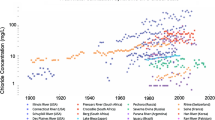Abstract
The options for large scale liming of river systems are reviewed with particular reference to the River Tywi in Wales, a major salmonid river with a reservoir in the upper catchment. For hydrological source area liming the cost of lime transport is high due to remoteness and inaccessibility. The concern of potential damage to wetland mires of conservation value is considered. Re-treatment intervals are expected to be 5–10 years, but results from sub-catchment experiments indicate that treatment longevity and the pattern of ecological recovery are uncertain. Flow-related dosing systems for rivers avoid impacts on wetlands but would treat only the main river. Reliability may be problematical though the reservoir provides a margin of safety against system failure. Reservoirs can be limed to treat the main river outflow. This avoids the problems of power supply. For the River Tywi, the financial costs of both direct treatment methods are lower than for catchment liming and comparable with estimates of the economic benefit to the fishery. The system currently operated on the Tywi is reservoir treatment. Results from the first 3 years demonstrate colonization of the main river by acid intolerant invertebrate taxa and clear increases in populations of juvenile Atlantic salmon, Salmo salar L. and sea/brown trout. Salmo trutta L.
Similar content being viewed by others
References
Bell, R: 1992. “Liming design and strategy at Loch Fleet”, p. 153–171 in: Restoring acid waters: Loch Fleet1984–1990; edited by G. Howells and T.R.K. Dalziel. Elsevier Applied Science.
Comber. S.D.W., Whitehead, P.G. & Gardner, M.J: 1995 “Water quality modelling of Llyn Brianne and its input streams”. Wrc report to NRA, contract 09316-0.
Critical Loads Advisory Group: 1995, “Critical Loads of Acid Deposition for United Kingdom Freshwaters”. Report to the Department of the Environment. London.
Edwards, R.W., Gee, A.S. & Stoner, J.H.. Eds: 1990 “Acid Waters in Wales” Kluwer, Dordrecht.
Evans, D.M.: 1994 “Sea trout studies (Salmo trutta L.) of the River Tywi, South Wales”. PhD Thesis, University of Hull.
Gee. A.S. & Stoner, J.H.: 1988, “The effects of afforestation and acid deposition on the water quality and ecology of upland Wales” Special Publication No. 7. British Ecological Society, 273–287.
Hindar, A.: 1985 “Lime treatment as a countermeasure”. pp23–39 in: Liming of Acid Waters. Final Technical Report on the Liming Project, edited by K. Baalsrud. Department of the Environment and the Directorate of Nature Management, Trondheim. Norway, pp23–39.
Jenkins, A., Waters, D. and Donald, A.: 1991 “An assessment of terrestrial liming strategies in upland Wales”. J. Hydrology 124, 254–261.
Lessmark, O. and Thornelof, E.: 1986, “Liming in Sweden”. Water Air and Soil Pollut. 30, 809–816.
Norrgren, L. and Degennan, E.: 1993. “Effects of durerent water qualities on the early development of Atlantic salmon and brown trout exposed in situ”. Ambio 22, 213–218.
Nyberg, P. and Thosuelof, E.: 1988. “Operational liming of surface waters in Sweden”. Water Air and Soil Pollut. 41. 3–16.
Olem, H.: 1991, “Liming Acidic Surface Waters”. Lewis Publ., Chelsea, Mi.
Ormerod, S.J. and Buckton, S.T.: 1994 “Catchment Source Areas and the Ecological Effects of Catchment Liming — Phase I and II”. NRA R&D Note 281.
Rogers, A.P., Jenkins, M. & Lloyd, C.: 1995, “Acid Waters: Llyn Brianne Project”. NRA R&D Note, Bristol.
Rundle, S.D.. Weatherley, N.S. & Onnerod, S.T.: 1995, “The effects of catchment liming on the chemistry and biology of upland Welsh streams: testing model predictions”. Freshwater Biology 34, 165–175
Simonin, H.A. et al.: 1990, “Final Generic Environmental Impact Statement of the New York Department of Environmental Conservation Program for Liming Selected Acidified Waters”. New York State Dev. Environ. Conserv. Albany.
Sverdrup, H. & Warfvinge, P.: 1985, “A reacification model for acidified lakes neutralized with calcite”. Water Resources Research 21, 1374–1380.
Turnpenny, A.W.H.: 1992,“Alternatives to Catchment Liming”. In, Restoring Acid Waters: Loch Fleet 1984–1990, edited by G. Howells & T.R.K. Dalziel, pp. 173–196. Elsevier Applied Science. London.
Underwood, J., Donald, A.P. and Stoner, J.H.: 1987. “Investigations into the use of limestone to combat acidification in two lakes in West Wales”. J. Environ. Mgmt. 24, 29–40.
Waters, D.. Jenkins, A., Staples, T. and Donald, A.P.: 1991, “The importance of hydrological source areas in terrestrial liming”. J. Inst. Water Eng. Mgr. 5. 336–341.
Weatherley, N.S., Rutt, G.P., Thomas, S.P. and Ormerod, S.J.: 1991, “Liming acid streams: toxicity to fish in mixing zones”. Water. Air and Soil Pollut. 55, 345–353.
Author information
Authors and Affiliations
Rights and permissions
About this article
Cite this article
Weatherley, N.S., Jenkins, M.J., Evans, D.M. et al. Options for liming rivers to ameliorate acidity — A UK perspective. Water Air Soil Pollut 85, 1009–1014 (1995). https://doi.org/10.1007/BF00476962
Issue Date:
DOI: https://doi.org/10.1007/BF00476962




